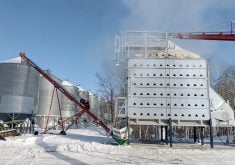Japan keeps increasing the amount of foreign beef it buys, despite a tariff increase to 50 percent from 38.5
TOKYO — Japan’s frozen beef imports have continued rising year on- year, despite the Aug. 1 tariff hike to 50 percent from 38.5.
Japan Ministry of Finance figures, currently available through November 2017, show a 16.72 percent year-on-year rise for total imports of frozen beef in the August-November period, from 637,303.15 tonnes in 2016 to 742,791.97 tonnes this year. Imports of just Canadian product rose 54.21 percent, from 3,421.96 to 5,277.13 tonnes.
The year-on-year increase shows up in the data every month since the tariff hike.
Total imports rose 12.65 percent from 182,694.39 tonnes in August 2016 to 207,413.57 tonnes the same month last year. The jump was 18.09 percent in September from 205,813.08 to 243,037.68 tonnes, 18.07 percent in October from 223,581.91 to 263,986.64 tonnes, and 12.45 percent in November from 637,303.15 to 742,791.97 tonnes.
Read Also

Saskatchewan puts crown land auction on hold
Auctions of Saskatchewan crown lease land are once again on hold.
For frozen beef from Canada only, the year-on-year leap was 64.15 percent in August, from 670.6 to 1,100.85 tonnes; 68.16 percent in September, from 776.42 to 1,305.66 tonnes; 52.37 percent in October, from 928.53 to 1,414.83 tonnes; and 39.12 percent in November from 1,046.40 to 1,455.78 tonnes.
It is precisely because of the constant increase in imports that the tariff snapback has been legally triggered. Whenever overall beef imports in a fiscal year quarter exceed by more than 17 percent import volumes in the same period of the previous year, tariffs rise from 38.5 to 50 percent.
When excessive imports show up only in the final figures for the entire preceding year, which come out in late April, the higher tariffs strike only in May and June of the new fiscal year. The increase is applied separately to chilled and frozen beef.
Tariff hikes under this system previously struck frozen beef in 1995 and 1996, as well as chilled beef in 2003, all on Aug. 1. Under trade agreements with Japan, beef from Australia and Mexico are now exempt from this tariff snapback.
However, the snapback is not expected to reverse the demand trend in favour of Australian beef because the Australian product already benefited from lower tariffs before the snapback, Meat and Livestock Australia Japan regional manager Andrew Cox said.
“The tariff on beef from ‘non-Economic Partnership Agreement (EPA) countries’ was already 38.5 percent before the snapback, whereas Japan tariffs on Australian beef are now below 30 percent (and going down) because of the Japan-Australia EPA,” Cox said.
In August, Australia and New Zealand, both Southern Hemisphere countries, were at the end of the winter season, and beef prices from those countries were high in the wake of a supply shortage of brisket, Tokyo-based Canada Beef International Institute (CBII) Asia executive director Daisuke Shimojima said.
As an alternative, demand for replacing the Southern Hemisphere countries’ meat with North American beef, including Canada, has increased.
“During the summer season, Japan market demand for beef from North America increased because of the relatively low price of the continent’s short plate due to the increase in production supply from July to September,” Shimojima said.
MEF Japan director Takemichi Yamashoji said there are several reasons for the import volume increase, including higher demand for beef in Japan.
“Japanese are learning that beef provides essential nutrients for healthy living, especially for the aging population,” Yamashoji said.
Frozen U.S. beef in particular is the most important ingredient in many dishes in the food service sector in Japan, he added, especially at gyudon chains, which serve bowls of rice topped with beef and onion simmered in a mildly sweet sauce.
The gyudon chains’ formulas are developed to highlight the taste of grain-fed U.S. beef, so they are reluctant to switch to other products, he said.
Because gyudon is a low profit margin product, there may be some negative impact of the tariff hike on U.S. beef over the next few months because many of the gyudon chains have long-term contracts with their suppliers, but those contracts are expiring, Yamashoji said.
“This may result in some substitution of U.S. product for others,” he said.
Japan Meat Traders Association executive director Shiroh Ohashi agreed with Yamashoji, saying demand for frozen beef has increased, especially for burger meat, which makes up the greater part of demand for the product.
Import volumes sharply increased in September, mainly from Australia, but that was primarily due to customs clearance of unmarked stocks that had accumulated because of the yen’s exchange rate appreciation in September with imports decreasing in October in reaction, Ohashi said.
Otherwise, not much has changed since the tariff hike.
“Import volumes of chilled beef increased, but that is considered to be due to an increase in meat eating in recent years,” Ohashi said.
The Japan Foodservice Association doesn’t think there is a direct causal relation between the tariff hike and import volumes.
Beef trading is basically a two-month unit, and for each transaction, contracts are made in June for July and August and in August for September and October, association managing director Kiyotoshi Tamura said.
Also, because July-August is the busy season for barbecue chains and other beef-serving restaurants, imports naturally increase.
“It is generally said that each trading company will adjust its inventory from November, and import volumes will go down,” Tamura said.
The Japan Chain store Association said there is no significant change in its members’ handling of their basically small volumes of frozen beef, customer purchases or shop front price.
















